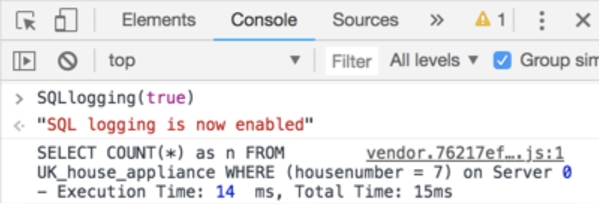Logs and Monitoring
HEAVY.AI writes to system logs and to HEAVY.AI-specific logs. System log entries include HEAVY.AI data-loading information, errors related to NVIDIA components, and other issues. For RHEL/CentOS, see /var/log/messages; for Ubuntu, see /var/log/syslog.
Most installation recipes use the systemd installer for HEAVY.AI, allowing consolidation of system-level logs. You can view the systemd log entries associated with HEAVY.AI using the following syntax in a terminal window:
journalctl -u heavydbBy default, HEAVY.AI uses rotating logs with a symbolic link referencing the current HEAVY.AI server instance. Logs rotate when the instance restarts. Logs also rotate once they reach 10MB in size. HeavyDB keeps a maximum of 100 historical log files. These logs are located in the /log directory.
The HEAVY.AI web server can show current log files through a web browser. Only super users who are logged in can access the log files. To enable log viewing in a browser, use the enable-browser-logs command; see the configuration parameters for HEAVY.AI web server.
You can configure several of the logging behaviors described above using runtime flags. See Configuration Parameters.
Log Entry Types
heavydb.INFO
This is the best source of information for troubleshooting, and the first place you should check for issues. Provides verbose logging of:
Configuration settings in place when
heavydbstarts.Queries by user and session ID, with execution time (time for query to run) and total time (execution time plus time spent waiting to execute plus network wait time).
Examples
Configuration settings in place when
heavydbstarts:
I1004 14:11:28.799216 1009 MapDServer.cpp:784] HEAVY.AI started with data directory at '/var/lib/heavyai/storage'
I1004 14:11:28.801699 1009 MapDServer.cpp:796] Watchdog is set to 1
I1004 14:11:28.801708 1009 MapDServer.cpp:797] Dynamic Watchdog is set to 0When you use the wrong delimiter, you might see errors like this:
E1004 20:12:00.929049 7496 Importer.cpp:1603] Incorrect Row (expected 21 columns, has 1): [JB141803,02/04/2018
E1004 20:12:19.426657 7494 Importer.cpp:3148] Maximum rows rejected exceeded. Halting loadheavydb.WARNING
Reports nonfatal warning messages. For example:
W1229 09:13:50.888172 36427 RenderInterface.cpp:1155] The string "Other" does
not have a valid id in the dictionary-encoded string column "card_class"
(aliased by "color") for table cc_trans.heavydb.ERROR
Logs non-fatal error messages, as well as errors related to data ingestion.
Examples
When the path in the
heavysqlCOPYcommand references an incorrect file or path.E1001 16:27:55.522930 2009 MapDHandler.cpp:4147] Exception: fopen(/tmp/25882.csv): No such file or directoryWhen the table definition does not match the file referenced in the
COPYcommand.E1001 16:30:58.710852 10436 Importer.cpp:1603] Incorrect Row (expected 58 columns, has 57): [MOBILE, EVDOA, Access...
heavydb.FATAL
heavydb.FATALReports `check failed` messages and a line number to identify where the error occurred. For example:
F1022 19:51:40.978567 14889 Execute.cpp:982]
Check failed: cd->columnType.is_string() && cd->columnType.get_compression() == kENCODING_DICTLive Logging
Browser-based Live Logging
Using Chrome’s Developer Tools, you can interact with data in Immerse to see SQL and response times from OmniSciDB. The syntax is SQLlogging(true), entered under the console tab inline, as shown below.

Once SQL Logging is turned on, you can interact with the dashboard, see the SQL generated and monitor the response timing involved.
Command-Line Live Logging
You can “tail” the logs using a terminal window from the logs folder (usually /log) by the following syntax in a terminal window and specifying the heavydb log file you want to view:
tail -f *.INFOMonitoring
Monitoring options include the following.
From the command line, you can run nvidia-smi to identify:
That the O/S can communicate with your NVIDIA GPU cards
NVIDIA SMI and driver version
GPU Card count, model, and memory usage
Aggregate memory usage by HEAVY.AI
You can also leverage systemd in non-Docker deployments to verify the status of heavydb:
sudo systemctl status heavydband heavy_web_server:
sudo systemctl status heavy_web_serverThese commands show whether the service is running (Active: active, (running)) or stopped (Active: failed (result: signal), or Active: inactive (dead)), the directory path, and a configuration summary.
Using heavysql, you can make these additional monitoring queries:
\status
Returns: server version, start time, and server edition.
In distributed environments, returns: Name of leaf, leaf version number, leaf start time.
\memory_summary
Returns a hybrid summary of CPU and GPU memory allocation. HEAVY.AI Server CPU Memory Summary shows the maximum amount of memory available, what is in use, allocated and free. HEAVY.AI allocates memory in 2 GB fragments on both CPU and GPU. HEAVY.AI Server GPU Memory Summary shows the same memory summary at the individual card level. Note: HEAVY.AI does not pre-allocate all of the available GPU memory.
A cold start of the system might look like this:
HEAVY.AI Server CPU Memory Summary:
MAX USE ALLOCATED FREE
412566.56 MB 8.19 MB 4096.00 MB 4087.81 MB
HEAVY.AI Server GPU Memory Summary:
[GPU] MAX USE ALLOCATED FREE
[0] 10169.96 MB 0.00 MB 0.00 MB 0.00 MB
[1] 10169.96 MB 0.00 MB 0.00 MB 0.00 MB
[2] 10169.96 MB 0.00 MB 0.00 MB 0.00 MB
[3] 10169.96 MB 0.00 MB 0.00 MB 0.00 MBAfter warming up the data, the memory might look like this:
HEAVY.AI Server CPU Memory Summary:
MAX USE ALLOCATED FREE
412566.56 MB 7801.54 MB 8192.00 MB 390.46 MB
HEAVY.AI Server GPU Memory Summary:
[GPU] MAX USE ALLOCATED FREE
[0] 10169.96 MB 2356.00 MB 4096.00 MB 1740.00 MB
[1] 10169.96 MB 2356.00 MB 4096.00 MB 1740.00 MB
[2] 10169.96 MB 1995.01 MB 2048.00 MB 52.99 MB
[3] 10169.96 MB 1196.33 MB 2048.00 MB 851.67 MB